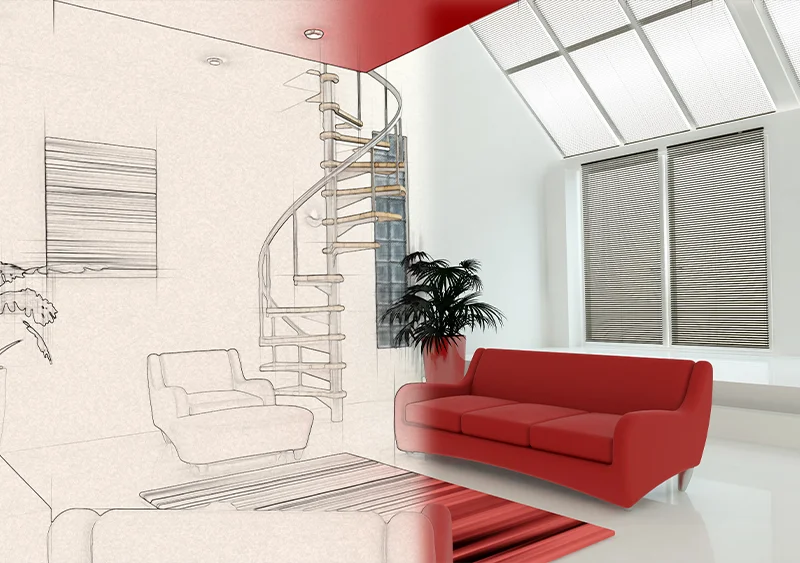Outsourcing 3D Visualization: A Strategic Guide for Business Leaders
A Strategic Guide to Outsourcing 3D Visualization for Business Growth

6 MIN READ
February 19, 2025

Written By
Sasikumar Janakiraman
High-quality 3D visualization plays a crucial role in sectors where visuals influence purchasing decisions and project approvals. Real estate developers rely on it to showcase properties before construction, architects use it for design validation, and e-commerce brands enhance customer experience with lifelike product renderings.
While an in-house team provides control, it demands significant investment in talent, infrastructure, and technology—making it impractical for many businesses.
Outsourcing offers a scalable and cost-effective alternative, enabling access to specialized expertise, faster turnaround times, and high-quality results. A well-executed outsourcing strategy ensures seamless collaboration, brand consistency, and measurable ROI.
This guide covers the critical factors for a successful outsourcing partnership, from selecting the right provider to avoiding common pitfalls, so you can make informed, strategic decisions.
The Growing Importance of 3D Visualization
In today's competitive markets, high-quality 3D visualization has become a critical tool for industries such as real estate, architecture, and e-commerce. These sectors rely on compelling visual content to engage customers and drive sales.
Enhanced Customer Engagement and Sales
Studies have shown that interactive 3D visualizations can significantly boost customer engagement. For instance, in e-commerce, engaged customers are reported to spend up to 60% more on products after experiencing 3D visualization.
In real estate, 3D renderings allow potential buyers to virtually tour properties, leading to faster decision-making and increased sales.
Cost and Resource Efficiency
Developing 3D visualizations in-house requires substantial investment in software, hardware, and skilled personnel. Outsourcing these services can be more cost-effective, with basic renders starting at around $50, while more detailed projects can cost upwards of $10,000.
Additionally, outsourcing eliminates expenses related to recruitment, training, and maintaining specialized equipment.
In summary, integrating 3D visualization into business strategies enhances customer engagement and operational efficiency.
In-House vs. Outsourced 3D Visualization: Choosing the Right Model for Your Business
Before investing in 3D visualization, businesses must decide whether to build an in-house team or outsource to a specialized provider. Each approach has distinct advantages and challenges.
The Cost of an In-House Team
Maintaining an internal 3D visualization team requires significant investment in talent, software, and infrastructure. A skilled 3D designer’s salary ranges between $60,000 and $100,000 per year, and software licenses such as Autodesk 3ds Max or Blender add $1,500 to $2,000 per user annually. Additional costs include hardware upgrades, training, and ongoing operational expenses.
Beyond financial costs, in-house production can be resource-intensive and slow. Complex projects often require weeks of iteration, which can delay marketing campaigns and project launches.
The Advantages of Outsourcing
Outsourcing offers a scalable and cost-effective alternative, eliminating overhead costs while providing access to top-tier expertise. Leading 3D visualization firms use the latest technology and industry best practices to deliver high-quality renderings 50% faster than most in-house teams.
By outsourcing, businesses can:
- Reduce costs by paying per project instead of maintaining full-time staff.
- Scale operations based on project demand without hiring additional employees.
- Improve efficiency with faster turnaround times from experienced professionals.
- Focus on core business functions while outsourcing partners handle visualization.
For companies requiring occasional or high-volume 3D assets, outsourcing is often the more strategic and cost-effective choice. However, for firms with constant, high-complexity visualization needs, an in-house team may be worth the investment.
Selecting the Right 3D Visualization Partner: Key Factors for Business Success
Outsourcing 3D visualization can be a strategic advantage, but the success of your projects depends on choosing the right partner. A reliable provider should align with your quality standards, business objectives, and project timelines. Here are the critical factors to evaluate:
1. Proven Track Record and Industry Expertise
A strong portfolio is non-negotiable. Look for case studies and past projects that match your industry’s standards, whether in real estate, architecture, or product visualization. Client testimonials and third-party reviews can provide insight into their credibility, work quality, and consistency.
2. Technical Capabilities and Software Proficiency
Ensure the provider is proficient in industry-leading tools such as 3ds Max, V-Ray, Unreal Engine, or Blender. These platforms are essential for high-quality, photorealistic renderings. The right partner should also be adaptable to your preferred formats and workflows, ensuring seamless integration with your internal processes.
3. Communication and Project Management
A lack of transparency can lead to missed deadlines and misaligned expectations. Select a provider with a structured workflow, clear milestones, and a dedicated point of contact. Regular progress updates, defined timelines, and upfront cost estimates minimize risks and ensure smooth collaboration.
4. Pilot Project for Evaluation
Before committing to a long-term partnership, conduct a trial project to assess their quality, responsiveness, and ability to meet deadlines. This step allows you to evaluate their workflow and adaptability before making a significant investment.
Choosing the right 3D visualization partner is a strategic decision that impacts efficiency, quality, and overall project success. A thorough vetting process ensures you work with a provider who meets your business needs and delivers results at scale.
The Outsourcing Process: A Step-by-Step Breakdown
Once you’ve selected the right 3D visualization partner, a structured process ensures efficiency, clarity, and high-quality results. Here’s how a typical outsourcing workflow unfolds:
Step 1: Project Briefing
A well-defined project brief is critical to achieving the desired outcome. Provide your outsourcing partner with:
- Project objectives and intended use of the 3D visuals
- Design specifications, including style, resolution, and file formats
- Reference materials, such as sketches, CAD files, or mood boards
- Timelines and deadlines to align expectations
The more precise the details, the fewer revisions and delays.
Step 2: Proposal and Agreement
Based on your brief, the provider will submit a detailed proposal covering:
- Scope of work
- Deliverables and file formats
- Timeline and milestones
- Pricing and payment structure
Review all terms carefully, ensuring clarity on revision policies, licensing rights, and confidentiality agreements before signing.
Step 3: Design and Iteration
The 3D team begins production based on your specifications. This phase typically involves:
- Initial drafts for concept validation
- Feedback loops to refine details and adjust visuals
- Rendering and post-production to enhance realism
A structured feedback process helps maintain efficiency and minimize unnecessary revisions.
Step 4: Final Review and Delivery
Once the visuals are refined, the final deliverables are provided in the agreed formats. Before project closure, conduct a quality check to ensure all requirements are met. Some providers also offer post-delivery support for minor adjustments or format conversions.
A streamlined outsourcing process reduces turnaround times, optimizes resources, and ensures consistent, high-quality results aligned with business objectives
Navigating the Complexities of Outsourcing 3D Visualization
Outsourcing 3D visualization offers efficiency and scalability, but success depends on structured communication, quality control, and workflow alignment. Clear project scope, reference materials, and regular check-ins prevent misalignment. Quality consistency comes from defined benchmarks, phased approvals, and trial projects.
Time zone differences can be managed with overlapping work hours and clear turnaround expectations.
To avoid over-reliance on a single provider, businesses should maintain backup vendors and secure intellectual property rights. When approached strategically, outsourcing becomes a powerful tool for delivering high-quality visuals while optimizing costs and resources.
Should You Outsource Your 3D Visualization?
If your goal is to maximize quality, efficiency, and ROI, then outsourcing 3D visualization could be the smartest move. It gives you access to expert designers, cutting-edge technology, and faster turnaround times—without the burden of maintaining an in-house team.
With the right outsourcing partner, you’ll be able to create stunning visuals that captivate your audience, drive sales, and boost brand reputation—all while saving valuable time and resources.
At Zealous 3D Design Studio, a Highly Acclaimed Worldwide 3D Studio, we specialize in 3D rendering services, offering high-quality visual content tailored to your business’s unique needs. With over 150,000 3D assets created and a team of 700+ professionals, we’ve been a trusted 3D partner since 2007. From eCommerce product prototyping to full-scale 3D content creation, we can help bring your ideas to life with precision and creativity.
Whether you're in real estate, architecture, e-commerce, or marketing, Zealous 3D Design Studio is here to elevate your brand and ensure your visuals make the impact you’ve been dreaming of.
About the writer :
Sasikumar Janakiraman, as the Creative Director at Zealous Services, brings a unique mix of creativity and technical ... skill. He’s passionate about 2D and 3D design, leading teams to create stunning 3D models and visualizations. Sasikumar loves working closely with clients, making sure their ideas come to life in the best possible way. His goal? To make design feel simple and exciting.
Read MoreFrequently Asked Questions (FAQ)
Why should I outsource 3D visualization instead of handling it in-house?
Outsourcing 3D visualization saves time, reduces costs, and gives you access to skilled professionals without the need for expensive software, training, or an in-house team. It allows you to focus on your core business while experts handle the technical aspects of visualization.
How do I choose the right 3D visualization outsourcing partner?
Look for a provider with a strong portfolio, positive client reviews, and experience in your industry. Clear communication, well-defined timelines, and an understanding of your project requirements are also key factors. Always request sample work or a trial project before committing.
How much does outsourcing 3D visualization cost?
Costs vary based on complexity, project scope, and the provider’s expertise. Simple product renders may cost a few hundred dollars, while high-end architectural visualizations can run into the thousands. It’s best to get a detailed quote upfront to avoid surprises.
How can I ensure high-quality results when outsourcing?
Provide clear project briefs, reference images, and expectations regarding style and detail. Regular check-ins, feedback loops, and milestone approvals help maintain quality and alignment with your vision.
Are there any risks involved in outsourcing 3D visualization?
Like any outsourcing process, risks include miscommunication, missed deadlines, and quality issues. Choosing a reputable provider, setting clear expectations, and maintaining open communication can mitigate these risks effectively.
Table Of Contents
The Growing Importance of 3D Visualization
In-House vs. Outsourced 3D Visualization: Choosing the Right Model for Your Business
Selecting the Right 3D Visualization Partner: Key Factors for Business Success
The Outsourcing Process: A Step-by-Step Breakdown
Navigating the Complexities of Outsourcing 3D Visualization